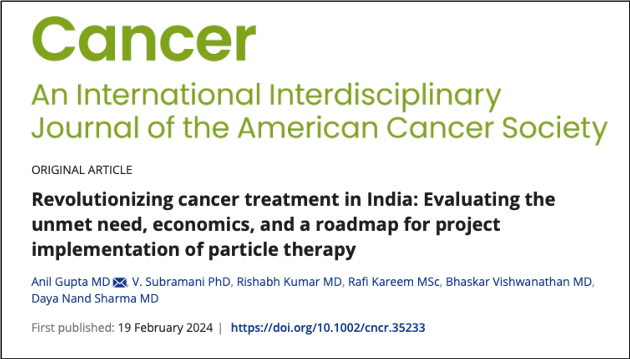Go to AFOMP Pulse Contents/Index Page
Journal: Cancer: An International Interdisciplinary Journal of the American Cancer Society
First published: 19 February 2024
https://doi.org/10.1002/cncr.35233
Revolutionizing cancer treatment in India: Evaluating the unmet need, economics, and a roadmap for project implementation of particle therapy
Anil Gupta MD1, V.Subramani PhD2,Rishabh Kumar MD3, Rafi Kareem MSc4,B. Vishwanathan MD3, Daya Nand Sharma MD2
1Department of Radiation Oncology, All India Institute of Medical Sciences, New Delhi, India
2Department of Radiation Oncology, All India Institute of Medical Sciences, New Delhi & National Cancer Institute, Jhajjar, Haryana, India
3Department of Radiation Oncology, Amrita Hospital, Faridabad, India
4Department of Medical Physics, Heidelberg Ion Therapy Center, Heidelberg, Germany
Abstract
Introduction: This study aims to quantitatively assess eligible patients and project the demand for particle therapy facilities in India from 2020 to 2040. In addition, an economic analysis evaluates the financial feasibility of implementing this technology. The study also examines the prospective benefits and challenges of adopting this technology in India.
Methodology: Cancer incidence and projected trends were analyzed for pediatric patients using the Global Childhood Cancer microsimulation model and adult patients using the Globocan data. Economic cost evaluation is performed for large‐ scale combined particle (carbon and proton‐three room fixed‐beam), large‐scale proton (one gantry and two fixed‐beam), and small‐scale proton (one gantry) facility. Results: By 2040, the estimated number of eligible patients for particle therapy is projected to reach 161,000, including approximately 14,000 pediatric cases. The demand for particle therapy facilities is projected to rise from 81 to 97 in 2020 to 121 to 146 by 2040. The capital expenditure is estimated to be only 3.7 times that of a standard photon linear accelerator over a 30‐year period. Notably, the treat- ment cost can be reduced to USD 400 to 800 per fraction, substantially lower than that in high‐income countries (USD 1000 to 3000 per fraction).

Conclusion: This study indicates that, in the Indian scenario, all particle therapy models are cost‐beneficial and feasible, with large‐scale proton therapy being the most suitable. Despite challenges such as limited resources, space, a skilled work- force, referral systems, and patient affordability, it offers substantial benefits. These include the potential to treat many patients and convenient construction and operational costs. An iterative phased implementation strategy can effectively overcome these challenges, paving the way for the successful adoption of particle therapy in India.
Plain Language Summary
In India, eligible patients benefiting from high‐precision particle therapy technology projected to rise till 2040. Despite high upfront costs, our study finds the long‐term feasibility of all particle therapy models, potentially offering a substantial reduction in treatment cost compared to high‐income countries. Despite challenges, India can succeed with an iterative phased approach.
KEYWORDS
cost‐benefit analysis, developing countries, health care economics and organizations, health services needs and demand, heavy ion radiotherapy, proton therapy.